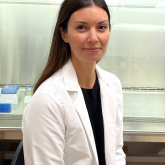Dr. Jordyn Broadbent (Bergsveinson)

Aquatic microbial ecology and aquatic toxicology.
Current research and/or projects
Contributing to ECCC's mandate to protect aquatic ecosystems through:
- Assessing biofilm dynamics, stability, and ecosystem services, in response to various contaminants.
- Pursuing application of "multi-omic" techniques to develop novel multi-panel biomarkers of agricultural contamination.
- Investigating biogeochemical cycling, microbial community dynamics and gene transfer in the context of One Health dynamics.
Research and/or project statements
- Application of metatranscriptomics, metagenomics, untargeted metabolomics to sediment and aquatic microbial communities impacted by agricultural or industrial outputs
- Multi-parameter assessment of impacts on biofilm structure and integrity under specific environmental conditions
- Assessment of aquatic environments as reservoirs and disseminators of antimicrobial resistance (AMR) and emerging pathogens
- Interested in means of incorporating ecological and sequencing data into environmental (and/or risk asessment) models
Professional activities / interests
Editor, Candian Journal of Microbiology
One Health policy and environmental research
Graduate student and post-doctoral fellow supervision and committees
Education and awards
Education:
Doctorate of Philosophy (PhD), College of Medicine, University of Saskatchewan 2015
Awards:
University of Regina Innovation Place: “Award of Innovation” 2019
NSERC Post-Doctoral Fellowship (University of Regina) 2018
Canadian Journal of Microbiology “Outstanding Reviewer” 2017; 2018
University of Saskatchewan Graduate Scholarship 2012-2015
Key publications
Relevant pulications:
- Flores-Vargas, G, Lawrence, JR, Bergsveinson, J. (2023). Sub-MIC antibiotics influence the microbiome, resistome and structure of riverine biofilm communities. Frontiers in Microbiology: Aquatic Microbiology 14: https://doi.org/10.3389/fmicb.2023.1194952
2nd maternity/parental leave: March 2021 – March 2022 (12 months)
- Flores-Vargas G, Bergsveinson J, Lawrence JR, Korber DR. (2021). Environmental biofilms as reservoirs for antimicrobial resistance. Frontiers in Microbiology 12: https://doi.org/10.3389/fmicb.2021.766242
- Russell JN, Perry BJ, Bergsveinson J, Freeman CN, Sheedy C, Nilsson D, Braul L, Yost CK. (2021). Metagenomic and metatranscriptomic analysis reveals enrichment for xenobiotic-degrading bacterial specialists and xenobiotic-degrading genes in a Canadian Prairie two-cell biobed system. Environmental Microbiology Reports. 13(5):720-727. https://doi.org/10.1111/1758-2229.12990
- Reid T and Bergsveinson J. (2021). How do the players play? A post-genomic analysis paradigm to understand aquatic ecosystem processes. Frontiers in Molecular Biosciences 8, https://doi.org/10.3389/fmolb.2021.662888.
- Bergsveinson J, Lawrence JR, Schebel A, Wasserscheid J, Roy J, Conly FM, Sanschagrin S, Korber DR, Tremblay J, Greer CW, Droppo IG. (2021). Impact of sample collection on prokaryotic and eukaryotic diversity of niche environments of the oil-sand mining impacted Athabasca River. Canadian Journal of Microbiology 67(11): 813-826. https://doi.org/10.1139/cjm-2021-0058.
- Bergsveinson, J, Roy, J, Maynard, C,Sanschargrin, S, Freeman, CN, Swerhone, GD, Dynes, JJ, Tremblay, J,Greer, CW, Korber, DR, Lawrence, JR. (2020). Metatranscriptomic insights into the response of river biofilm communities to ionic and nano-zinc oxide exposures. Frontiers Microbiology, sec: Aquatic Microbiology 11, https://doi.org/10.3389/fmicb.2020.00267.
1st maternity/parental leave: July 2019 – January 2020 (6 months)
- Bergsveinson, J, Perry, BJ, Simpson, GL, Yost, CKY, Schutzman, RJ, Hall, BD, Cameron, ADS. 2019. Spatial analysis of a hydrocarbon waste-remediating landfarm demonstrates influence of management practices on bacterial and fungal community structure. Microbial Biotechnology 12:1199–1209 doi:10.1111/1751-7915.13397.
- Bergsveinson, J, Perry, BJ, Sheedy, C, Braul, L, Reedyk, D, Gossen, BD, Yost, CKY. (2018). Identifying the core bacterial and fungal communities within four agricultural biobeds used for the treatment of pesticide rinsates. Journal of Applied Microbiology. 125:1333-1342.
- Bergsveinson, J, and Ziola, B. (2017). Comparative genomic and plasmid analysis of beer-spoiling and non-beer-spoiling Lactobacillus brevis isolates. Canadian Journal of Microbiology 63:970-983.
- Friesen, V, Bergsveinson, J, Ferris, B, and Haakensen, M. (2017). Pilot-scale testing of a passive water treatment system for Kumtor gold mine demonstrates beneficial microbes mediate treatment of ammonia produced from cyanide destruction. Ecological Engineering 100: 231-36.
- Bergsveinson, J, Ewen, E, Friesen, V, and Ziola, B. (2016). Transcriptional activity and role of plasmids of Lactobacillus brevis BSO 464 and Pediococcus claussenii ATCC BAA-344T during growth in the presence of hops. AIMS Microbiology 2: 460-78.
- McQueen, A, Kinley, CM, Rogers, JH, Friesen, V, Bergsveinson, J, and Haakensen, M. (2016). Influence of commercial (Fluka) naphthenic acids on acid volatile sulfide (AVS) production and divalent metal precipitation. Ecotoxicology and Environmental Safety 134: 86-94.
- Bergsveinson, J, Friesen, V, and Ziola, B. (2016). Transcriptome analysis of beer-spoiling Lactobacillus brevis BSO 464 in degassed and gassed beer. International Journal of Food Microbiology 235: 28-35.
- Bokulich, N, Bergsveinson, J, Ziola, B, and Mills, DA. (2015). Mapping microbial ecosystems and spoilage-gene flow in breweries highlights patterns of contamination and resistance. eLife 4: e04636.
Research facility
Expertise
Affiliations
Adjunct Professor, Department of Agriculture, University of Saskatchewan
 ORCID
ORCID